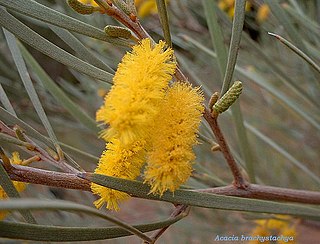
Acacia brachystachya, commonly known as umbrella mulga, turpentine mulga or false bowgada, is a shrub in the family Fabaceae. The species occurs in mulga and heath communities on sandhills and rocky ridges in all mainland states of Australia, except Victoria.
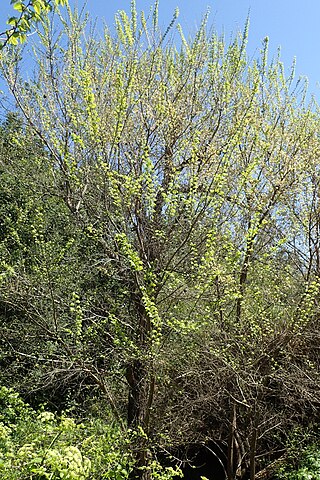
Ulmus minorsubsp.canescens is a small deciduous tree occasionally known by the common names grey elm, grey-leafed elm, and hoary elm. Its natural range extends through the lands of the central and eastern Mediterranean, from southern Italy, the islands of Sicily, Malta, Crete, Rhodes and Cyprus, to Turkey, and as far south as Israel, where it is now considered rare and endangered in the wild. The tree is typically found amidst the comparatively humid coastal woodlands and scrublands.

Banksia nobilis, commonly known as the golden dryandra, great dryandra or kerosene bush, is a shrub of the family Proteaceae which is endemic to Western Australia. It occurs on lateritic rises from Eneabba to Katanning in the state's Southwest Botanic Province. With large pinnatifid leaves with triangular lobes, and a golden or reddish pink inflorescence, it is a popular garden plant. It was known as Dryandra nobilis until 2007, when all Dryandra species were transferred to Banksia by Austin Mast and Kevin Thiele. There are two subspecies, B. nobilis subsp. nobilis and B. nobilis subsp. fragrans.

Banksia proteoides, commonly known as king dryandra, is a shrub endemic to Western Australia. It was known as Dryandra proteoides until 2007, when all Dryandra species were transferred to Banksia by Austin Mast and Kevin Thiele.

Banksia stuposa is a species of shrub that is endemic to the southwest of Western Australia. It has hairy stems, broadly linear pinnatifid leaves, golden yellow and white flowers in heads of one hundred or more, and hairy, egg-shaped follicles.
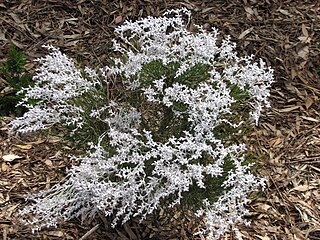
Conospermum stoechadis, commonly known as common smokebush, is a shrub endemic to Western Australia.

Micranthes nivalis is a plant species in the saxifrage family. It is commonly called snow saxifrage or (ambiguously) alpine saxifrage.

The National Herbarium of Victoria is one of Australia's earliest herbaria and the oldest scientific institution in Victoria. Its 1.5 million specimens of preserved plants, fungi and algae—collectively known as the State Botanical Collection of Victoria—comprise the largest herbarium collection in Australia and Oceania.

Darwinia citriodora, commonly known as lemon-scented darwinia or lemon scented myrtle, is a plant in the myrtle family Myrtaceae and is endemic to the south-west of Western Australia. It is a shrub with oblong to lance-shaped leaves and red, yellow and orange flowers over an extended period. It is a hardy plant in well-drained soil, is often cultivated and used as a rootstock for less hardy species.

Acacia truncata, commonly known as the angle leaved wattle or west coast wattle, is a coastal shrub in the family Fabaceae, with a native distribution along the southwest coast of Western Australia. A specimen of this wattle was part of an early European botanical collection, perhaps the first from Australia.

Johnsonia pubescens, commonly called the pipe lily, is a grass-like plant in the family Asphodelaceae, subfamily Hemerocallidoideae, endemic to the south-west of Western Australia. As with others in the genus, it is distinguished by its minute flowers which are on the end of a spike and hidden by large, overlapping, papery bracts.
The Australasian Virtual Herbarium (AVH) is an online resource that allows access to plant specimen data held by various Australian and New Zealand herbaria. It is part of the Atlas of Living Australia (ALA), and was formed by the amalgamation of Australia's Virtual Herbarium and NZ Virtual Herbarium. As of 12 August 2014, more than five million specimens of the 8 million and upwards specimens available from participating institutions have been databased.

Billardiera fraseri is a species of plant in the family, Pittosporaceae, which is endemic to Western Australia.
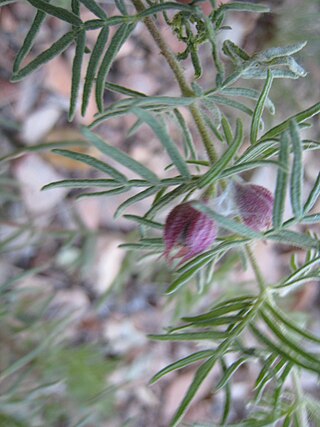
Boronia lanuginosa is a plant in the citrus family Rutaceae and is endemic to northern Australia. It is a shrub with woolly pinnate leaves.
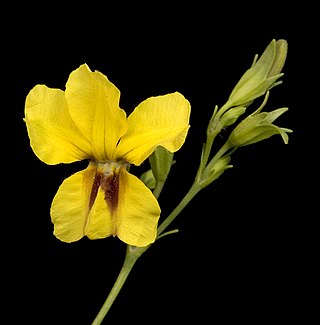
Velleia macrophylla, or large-leaved Velleia, is a perennial herb in the family Goodeniaceae, which is endemic to Western Australia. It grows on moist sites in Beard's South-west province. It flowers from October to December or January.

Scaevola acacioides, is an erect, spreading shrub in the family Goodeniaceae.
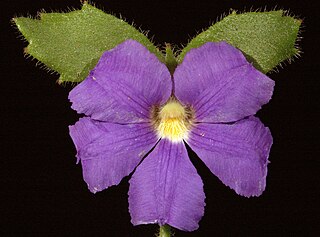
Scaevola pilosa, commonly known as the hairy fan-flower, is a perennial herb in the family Goodeniaceae. It is endemic to the southwest of Western Australia.

Kennedia carinata is a species of flowering plant in the family Fabaceae and is endemic to the south-west of Western Australia. It is a prostrate shrub with trifoliate leaves and reddish-purple, pea-like flowers.

Scaevola anchusifolia commonly known as silky scaevola, is a species of flowering plant in the family Goodeniaceae. It is a small, upright or decumbent shrub with fan-shaped blue to bluish white flowers and is endemic to Western Australia.

Scaevola thesioides is a species of flowering plant in the family Goodeniaceae and is endemic to the southwest of Western Australia. It is a spreading subshrub to perennial herb with thread-like to lance-shaped leaves and hairy, fan-shaped, pale blue to white flowers.




















